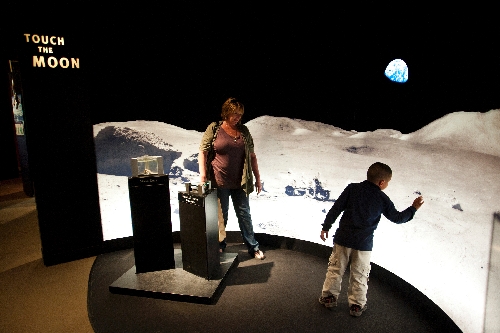Springs Preserve exhibit explores space
Last July, the space shuttle Atlantis returned to Earth following the 135th -- and final -- shuttle mission, ending more than 50 years of Americans in space. At least for now.
But there's still one place Southern Nevadans can get in touch with their inner astronaut -- or astrophysicist.
That's "Space: A Journey to Our Future."
The touring exhibit, on display in the Springs Preserve's Origen Museum through May 13, provides a hands-on, heads-up look at humanity's past, present -- and future -- fascination with space.
The latest in the preserve's series of family-friendly, hands-on science and nature exhibits, "Space: A Journey to Our Future" enables visitors to experience everything from spaceship design to exercise in space.
So far, "it's been very, very popular" with visitors, says Aaron Micallef , curator of exhibits, who notes that the Springs Preserve sold a record number of memberships during the exhibit's member-preview day.
Part of the exhibit's appeal -- and space's overall popularity -- can be traced to "the mystery of the unknown," Micallef suggests.
Also, most kids today "have a parent or grandparent who was alive during the beginning of the space race" in the 1950s and '60s, he points out, so "it's not like talking about the Civil War" with the younger generation.
One case in point: Las Vegan Linda Viera , visiting the exhibit with her 8- and 4-year-old nephews, noted a photo of the Challenger astronauts -- all of whom perished Jan. 28, 1986, when their space shuttle burst into flames 73 seconds after launch.
"I watched that on television," she told them, illustrating Micallef's direct-connection-to-history theory.
The exhibit begins with pieces of the past, including an early edition of Jules Verne's 1874 novel "From the Earth to the Moon," featuring an illustration of the moon with the caption "It was an enormous disc."
But that was fiction.
Factual, tangible evidence of humanity's successful voyage to the moon is as close as the giant, metal-wrapped tire from a NASA lunar rover. Also on display: a Hasselblad camera used on the Apollo 17 moon mission, a fuel cell from an Apollo service module and a flight suit worn by a space shuttle astronaut.
There's also a real moon meteorite, with a "Please Touch" sign displayed alongside.
By contrast, the moon rock next to the meteorite sits safely inside a closed display case, complete with a "Do Not Touch" warning. (That seems fitting, considering that a courier traveled by air to deliver the moon rock; the rest of the touring exhibit arrived on five trucks, four of them semitrailers, Micallef notes.)
After experiencing some of America's history in space, visitors blast off for the future with a variety of interactive exhibits.
A large video screen introduces "The Infrared You," outlining heat-emitting areas in orange and red; cooler body parts appear in icy blues.
"That's me, Dad!" one delighted young explorer squeals, reacting to his infrared image as it darts across the video screen.
Crank a handle on another display and images of outer space spin past, capturing the same views as the Hubble Space Telescope, launched into orbit during a 1990 space shuttle flight.
Dieter's-dream scales measure what your weight would be on the moon or on Mars. (It's guaranteed to be a fraction of what you weigh here on Earth, thanks to the weaker gravitational pull in space.)
One interactive display invites visitors to design their own starship; touch-screen prompts ask about everything from fuel source (nuclear? ion?) to the craft's final destination. (If it's the moon, it'll take only four days to get there; choose Jupiter and you'll be stuck onboard for five years -- a mere blip compared with a six-decade jaunt to the Alpha Centauri star system.)
"Excellent work, rocket scientist," the computer responds after you've completed your spaceship plan. "Your new design will be the envy of the entire space fleet."
Visitors also can experience "Spacercise" aboard a trio of recumbent space bicycles that spin, conveying the feeling of weightlessness through the use of centrifugal force.
A few more steps and you're in August 2033, inside Base Camp Alpha, as an astronaut on a video screen welcomes you to Mars with a friendly "It's nice to see some new faces."
Inside: sleeping bays for intrepid explorers, and a kitchen area with packaged meals ranging from scrambled eggs to pasta primavera.
There's even a research station where visitors can employ video-game skills, operating a joystick to fly a microprobe-equipped rover over the Martian surface to check out such unusual surface features as a 958-foot dust devil spinning at 40 mph, despite the 80-below temperature on the Martian surface.
At another interactive station, astronaut Ruby Redstone pops up on a computer monitor, inviting participants to "Pack for a Trip to Mars" by selecting such necessities as oxygen, fuel and food. (And, assuming there's room aboard your spacecraft, leisure-time pursuits from a DVD player to a video game device.)
"You've loaded all the essentials," Redstone reacts. "Congratulations -- you are a hotshot and rising star in the space program."
And perhaps that's one of the goals of the exhibit, which includes video footage of Apollo 17 astronaut Eugene Cernan -- who, in December 1972, became the last human to walk on the moon.
"I can't be the last," Cernan tells visitors in the video. "It is up to each of us to make sure that new steps are taken in the cosmos. Maybe someday you'll be the ones taking those steps."
Contact reporter Carol Cling at ccling@reviewjournal.com or (702) 383-0272.
Preview
"Space: A Journey to Our Future"
10 a.m. to 6 p.m. daily through May 13
Springs Preserve, 333 S. Valley View Blvd.
Admission included with general admission: $4.95-$9.95 for Nevada residents, $8.95-$19.95 for nonresidents (822-7700;
springspreserve.org)























